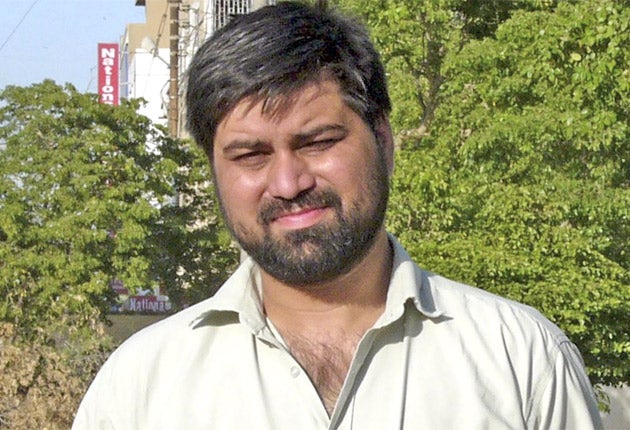Call for inquiry into Pakistani journalist Syed Saleem Shahzad's murder

Your support helps us to tell the story
From reproductive rights to climate change to Big Tech, The Independent is on the ground when the story is developing. Whether it's investigating the financials of Elon Musk's pro-Trump PAC or producing our latest documentary, 'The A Word', which shines a light on the American women fighting for reproductive rights, we know how important it is to parse out the facts from the messaging.
At such a critical moment in US history, we need reporters on the ground. Your donation allows us to keep sending journalists to speak to both sides of the story.
The Independent is trusted by Americans across the entire political spectrum. And unlike many other quality news outlets, we choose not to lock Americans out of our reporting and analysis with paywalls. We believe quality journalism should be available to everyone, paid for by those who can afford it.
Your support makes all the difference.As the friends and family of Syed Saleem Shahzad said prayers and buried the murdered reporter, journalists across Pakistan flew black flags in protest and demanded a genuine investigation be opened into his death.
The body of Mr Shahzad, 40, the correspondent for Asia Times Online, was flown from Islamabad to his home city of Karachi and laid to rest at the Qayyumabad graveyard yesterday. Earlier, hundreds of people had said funeral prayers for him at the city’s Mubarak mosque.
The discovery of Mr Shahzad’s body, along with his car and identity card, about 100 miles south of Islamabad, was revealed on Tuesday afternoon. His body had been found in a shallow canal the day before by villagers in the Mandi Bahauddin district.
The reporter had gone missing two days earlier after failing to arrive at a television studio in Islamabad where he was due to take part in a discussion about his latest article, which highlighted alleged links between al-Qa’ida and members of the Pakistani Navy. Human Rights Watch has said it has credible evidence that he was picked up by the InterServices Intelligence (ISI) agency. His family had been told he would be returned by Monday evening.
Mr Shahzad, who was married with three children, had been badly beaten and his body bore 15 injury marks. His lungs and liver had also been damaged. “The cause of death is torture and there are several signs of torture on his body and face,” Ashok Kumar, one of the doctors who carried out a post-mortem examination at Islamabad’s Pakistan Institute of Medical Science, told Agence France-Presse.
Wasim Fawad, a brother of Mr Shahzad, said the family was in shock. “We want an investigation into this killing,” he said. “My brother was killed for writing the truth. He paid a huge price, he sacrificed his life but always spoke the truth.”
The killing has triggered outrage across Pakistan, which campaigners said last year achieved the distinction of being the deadliest place for journalists to operate. At least 11 reporters and media workers were killed in the course of the year, said the Committee to Protect Journalists. Yesterday it published a report highlighting the “impunity” with which journalists have been killed over the past decade. It said 251 journalists in 13 countries had been killed without any action being taken against the perpetrators.
Mr Shahzad’s family, along with journalists across the country, have demanded that an exhaustive inquiry be completed into the killing. Pervaiz Shaukat, president of the Pakistan Federal Union of Journalists, said he had spoken to the country’s Information Minister and requested the government establish a commission headed by a supreme court judge to investigate. “There are protests across the country. For three days we will be flying black flags,” he said. “We have lost six journalists this year already. It’s a very serious situation in Pakistan.”
In condemning the killing, Hilary Clinton, the US Secretary of State, said America supported the Pakistani government undertaking to carry out an investigation. “His work reporting on terrorism and intelligence issues in Pakistan brought to light the troubles extremism poses to Pakistan’s stability,” she added.
Mr Shahzad, who had contacts both within the intelligence community and among the Taliban and al-Qa’ida militants, disappeared two days after the publication of an article about the recent attack by militants on the Mehran naval base in Karachi. He said that al-Qa’ida had infiltrated the naval ranks and that the attack occurred after negotiations between the militants and the military broke down.
Ali Dayan Hasan of Human Rights Watch said Mr Shahzad had told him of threats he had received and that he had sent him an email about an occasion last October when he was called in for questioning by the ISI about an earlier article. The meeting had been polite, but at the end of the discussion one of the ISI officers made a comment to the journalist that he read as a threat.
Given the widespread belief that Mr Shahzad may have been seized and killed because of his most recent article, which was advertised as being the first of a two-part series, there has been intense speculation about the contents of the as yet unpublished part. Tony Allison, the editor of Asia Times, said yesterday it was unclear whether the second part would now be published. He said it did not contain any sensational material and that Mr Shahzad had been in the process of redrafting it when he was killed.
“I often spoke to him [about the dangers]” said Mr Allison. “His comment to me was that unless he was doing his job he might as well be making tea. That was even when he received specific death threats. Several times I said to lay low and back down, but he never did.”
Join our commenting forum
Join thought-provoking conversations, follow other Independent readers and see their replies
Comments